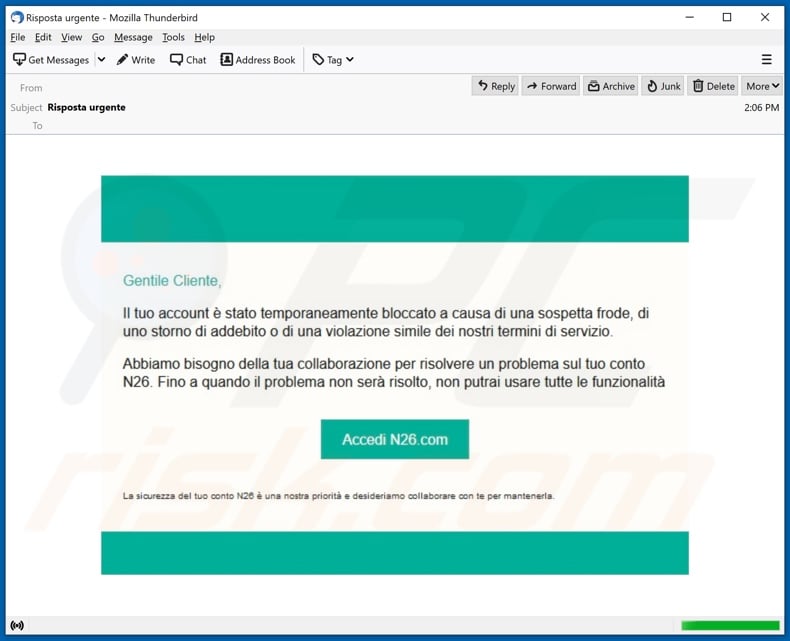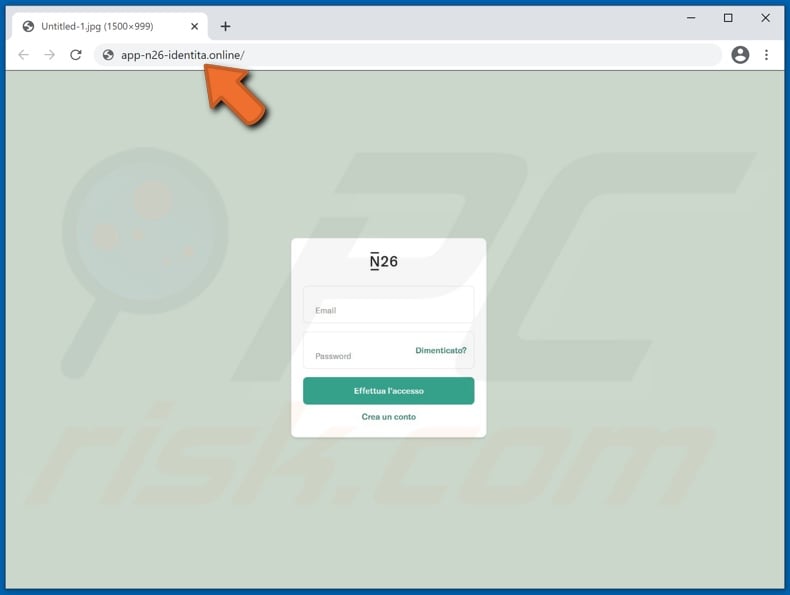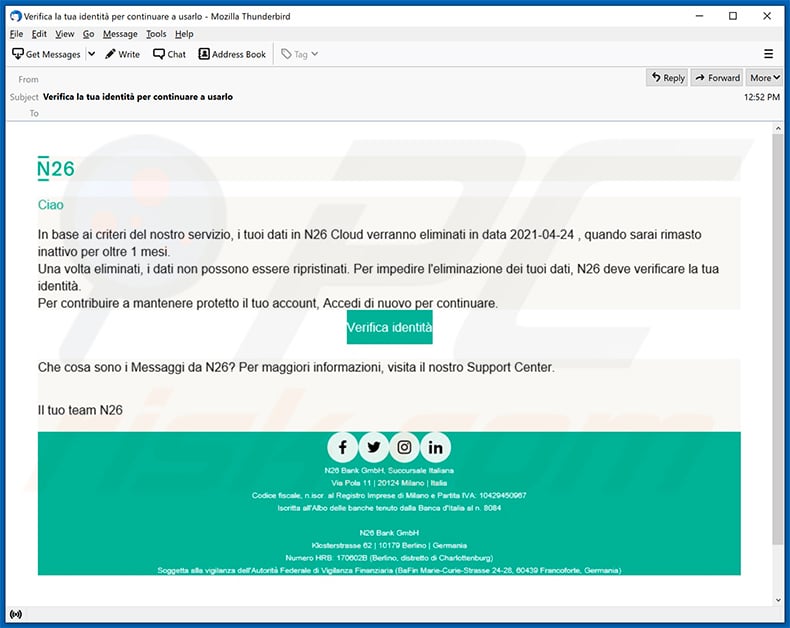Avoid having your N26 bank account stolen via phishing spam emails
Phishing/ScamAlso Known As: N26 spam
Get free scan and check if your device is infected.
Remove it nowTo use full-featured product, you have to purchase a license for Combo Cleaner. Seven days free trial available. Combo Cleaner is owned and operated by RCS LT, the parent company of PCRisk.com.
What is the fake "N26" email?
"N26 Email Scam" is a the name of a spam campaign targeting Italian-speaking N26 bank clients. The term "spam campaign" defines a mass-scale operation during which thousands of deceptive emails are sent. N26 is a legitimate online bank headquartered in Berlin, Germany.
The "N26 Email Scam" messages are disguised as mail from the aforementioned bank. The scam emails make false claims that recipients' N26 banking accounts have been suspected. This campaign aims to promote a phishing website, which is presented as the sign-in page to N26 bank accounts.
Log-in credentials (i.e., emails and passwords) entered into this site will be exposed to the scammers behind the "N26 Email Scam".

According to a rough translation, "N26 Email Scam" messages (the subject/title "Risposta urgente" may vary) inform recipients that their N26 banking accounts have been temporarily suspended. This suspension has occurred due to violated N26's terms of service. The potential violations include fraud, chargeback, or other dubious financial activity.
The scam emails require recipient cooperation to resolve the nonexistent issue. The messages warn that recipients will be unable to use all features of their N26 bank accounts until appropriate action is taken. As mentioned, the "N26 Email Scam" messages are fake. They are in no way associated with the actual N26 online bank, and none of the information provided by them is genuine.
The button ("Accedi N26.com") presented in the "N26 Email Scam" messages leads to a phishing site, which closely imitates the genuine N26 banking account sign-in page. Hence, by entering their log-in credentials (i.e., emails and usernames), users will not access their accounts, but instead will inadvertently reveal the entered data.
Though stolen bank accounts, scammers can make fraudulent transactions and online purchases. Therefore, by trusting these scam emails, users can lose their N26 bank accounts, experience financial loss, and severe privacy issues.
If attempts to log-in via the phishing web page have already been made, change the potentially compromised account credentials and contact the official support of N26 bank.
| Name | N26 Email Scam |
| Threat Type | Phishing, Scam, Social Engineering, Fraud |
| Fake Claim | Scam emails claim recipients' N26 bank accounts have been suspended. |
| Disguise | Scam emails are disguised as mail from the N26 online bank. |
| Related Domains | app-n26-identita[.]online |
| Detection Names (app-n26-identita[.]online) | Emsisoft (Phishing), Sophos (Phishing), ESTsecurity-Threat Inside (Phishing), Kaspersky (Phishing), Fortinet (Suspicious), Full List Of Detections (VirusTotal) |
| Serving IP Address (app-n26-identita[.]online) | 192.64.119.237 |
| Symptoms | Unauthorized online purchases, changed online account passwords, identity theft, illegal access of the computer. |
| Distribution methods | Deceptive emails, rogue online pop-up ads, search engine poisoning techniques, misspelled domains. |
| Damage | Loss of sensitive private information, monetary loss, identity theft. |
| Malware Removal (Windows) |
To eliminate possible malware infections, scan your computer with legitimate antivirus software. Our security researchers recommend using Combo Cleaner. Download Combo CleanerTo use full-featured product, you have to purchase a license for Combo Cleaner. 7 days free trial available. Combo Cleaner is owned and operated by RCS LT, the parent company of PCRisk.com. |
"Email Disabling Service", "Credito Agricola", "Stopped processing incoming emails", and "Amazon Customer Care Email Scam" are some examples of other phishing spam campaigns. Deceptive/Scam emails are usually disguised as "official", "priority", "urgent", "important", and so on.
These messages are used not only for phishing but also to facilitate other scams and to proliferate malware. Spam campaigns are employed to spread Trojans, ransomware, cryptominers, and other malicious programs. Due to the relative prevalence of scam mail, exercise caution with incoming emails.
How do spam campaigns infect computers?
Malware (including ransomware) is usually distributed via malspam campaigns, unofficial software activation ('cracking') tools, Trojans, dubious file/software download sources, and fake software updating tools.
When cyber criminals attempt to distribute malware via malspam campaigns, they send emails that contain malicious attachments or download links for malicious files. Typically, they disguise their emails as official and important. If recipients open the attached file (or a file downloaded via a website link), they cause installation of malicious software.
Cyber criminals commonly attach executable files (.exe), archive files such as RAR, ZIP, PDF documents, JavaScript files and Microsoft Office documents to their emails. Software 'cracking' tools supposedly activate licensed software illegally (bypass activation), however, they often install malicious programs and do not activate any legitimate installed software.
Trojans are other rogue programs that can cause chain infections. I.e., when a Trojan is installed on the operating system, it can install additional malware.
Free file hosting websites, freeware download websites, Peer-to-Peer networks (e.g., torrent clients, eMule), unofficial websites, and third party downloaders are examples of other sources that are used to distribute malware. Cyber criminals disguise malicious files as legitimate and regular. When users download and open them, they inadvertently infect their computers with malware.
Fake software updating tools install malicious software rather than updates/fixes for installed programs, or they exploit bugs/flaws of outdated software that is installed on the operating system.
How to avoid installation of malware
To avoid malware spread via spam mail, you are strongly advised against opening suspicious or irrelevant emails, especially those with any attachments or links present within them.
Additionally, use Microsoft Office versions released after 2010. Malicious programs also proliferate through untrusted download channels (e.g. unofficial and free file-hosting sites, Peer-to-Peer sharing networks and other third party downloaders), illegal software activation ("cracking") tools, and fake updaters.
Therefore, only download from official/verified sources and activate and update software with tools/functions provided by legitimate developers.
To ensure device integrity and user privacy, have a reputable anti-virus/anti-spyware suite installed and kept updated. Furthermore, use these programs to run regular system scans and to remove detected/potential threats.
If you have already opened malicious attachments, we recommend running a scan with Combo Cleaner Antivirus for Windows to automatically eliminate infiltrated malware.
Text presented in the fake "N26" email message:
Subject: Risposta urgente
Gentile Cliente,
Il tuo account è stato temporaneamente bloccato a causa di una sospetta frode, di uno storno di addebito o di una violazione simile dei nostri termini di servizio.
Abbiamo bisogno della tua collaborazione per risolvere un problema sul tuo conto N26. Fino a quando il problema non sera risolto, non putrai usare tutte le funzionalità
Accedi N26.com
La sicurezza del tuo conto N26 è una nostra priorità e desideriamo collaborare con te per mantenerla.
Screenshot of the phishing website promoted through "N26 Email Scam" campaign:

Yet another variant of N26 bank-themed spam email:

Text presented within:
Subject: Verifica la tua identità per continuare a usarlo
N26
Ciao
In base ai criteri nostro servizio, i tuoi dati in N26 Cloud verranno eliminati in data 2021-04-24 , quando sarai rimasto inattivo per oltre 1 mesi.
Una volta eliminati, i dati non possono essere ripristinati. Per impedire l'eliminazione dei tuoi dati, N26 deve verificare la tua identità.
Per contribuire a mantenere protetto il tuo account, Accedi di nuovo per continuare.
[Verifica identità]Che cosa sono i Messaggi da N26? Per maggiori informazioni, visita il nostro Support Center.
Il tuo team N26
N26 Bank GmbH, Succursale Italiana
Via Pola 11 | 20124 Milano | Italia
Codice fiscale, n.iscr. al Registro Imprese di Milano e Partita IVA: 10429450967
Iscritta all'Albo delle banche tenuto dalla Banca d'Italia al n. 8084N26 Bank GmbH
Klosterstrasse 62 | 10179 Berlino | Germania
Numero HRB: 170602B (Berlino, distretto di Charlottenburg)
Soggetta alla vigilanza dell'Autorità Federale di Vigilanza Finanziaria (BaFin Marie-Curie-Strasse 24-28, 60439 Francoforte, Germania)
Instant automatic malware removal:
Manual threat removal might be a lengthy and complicated process that requires advanced IT skills. Combo Cleaner is a professional automatic malware removal tool that is recommended to get rid of malware. Download it by clicking the button below:
DOWNLOAD Combo CleanerBy downloading any software listed on this website you agree to our Privacy Policy and Terms of Use. To use full-featured product, you have to purchase a license for Combo Cleaner. 7 days free trial available. Combo Cleaner is owned and operated by RCS LT, the parent company of PCRisk.com.
Quick menu:
- What is N26 spam?
- Types of malicious emails.
- How to spot a malicious email?
- What to do if you fell for an email scam?
Types of malicious emails:
![]() Phishing Emails
Phishing Emails
Most commonly, cybercriminals use deceptive emails to trick Internet users into giving away their sensitive private information, for example, login information for various online services, email accounts, or online banking information.
Such attacks are called phishing. In a phishing attack, cybercriminals usually send an email message with some popular service logo (for example, Microsoft, DHL, Amazon, Netflix), create urgency (wrong shipping address, expired password, etc.), and place a link which they hope their potential victims will click on.
After clicking the link presented in such email message, victims are redirected to a fake website that looks identical or extremely similar to the original one. Victims are then asked to enter their password, credit card details, or some other information that gets stolen by cybercriminals.
![]() Emails with Malicious Attachments
Emails with Malicious Attachments
Another popular attack vector is email spam with malicious attachments that infect users' computers with malware. Malicious attachments usually carry trojans that are capable of stealing passwords, banking information, and other sensitive information.
In such attacks, cybercriminals' main goal is to trick their potential victims into opening an infected email attachment. To achieve this goal, email messages usually talk about recently received invoices, faxes, or voice messages.
If a potential victim falls for the lure and opens the attachment, their computers get infected, and cybercriminals can collect a lot of sensitive information.
While it's a more complicated method to steal personal information (spam filters and antivirus programs usually detect such attempts), if successful, cybercriminals can get a much wider array of data and can collect information for a long period of time.
![]() Sextortion Emails
Sextortion Emails
This is a type of phishing. In this case, users receive an email claiming that a cybercriminal could access the webcam of the potential victim and has a video recording of one's masturbation.
To get rid of the video, victims are asked to pay a ransom (usually using Bitcoin or another cryptocurrency). Nevertheless, all of these claims are false - users who receive such emails should ignore and delete them.
How to spot a malicious email?
While cyber criminals try to make their lure emails look trustworthy, here are some things that you should look for when trying to spot a phishing email:
- Check the sender's ("from") email address: Hover your mouse over the "from" address and check if it's legitimate. For example, if you received an email from Microsoft, be sure to check if the email address is @microsoft.com and not something suspicious like @m1crosoft.com, @microsfot.com, @account-security-noreply.com, etc.
- Check for generic greetings: If the greeting in the email is "Dear user", "Dear @youremail.com", "Dear valued customer", this should raise suspiciousness. Most commonly, companies call you by your name. Lack of this information could signal a phishing attempt.
- Check the links in the email: Hover your mouse over the link presented in the email, if the link that appears seems suspicious, don't click it. For example, if you received an email from Microsoft and the link in the email shows that it will go to firebasestorage.googleapis.com/v0... you shouldn't trust it. It's best not to click any links in the emails but to visit the company website that sent you the email in the first place.
- Don't blindly trust email attachments: Most commonly, legitimate companies will ask you to log in to their website and to view any documents there; if you received an email with an attachment, it's a good idea to scan it with an antivirus application. Infected email attachments are a common attack vector used by cybercriminals.
To minimise the risk of opening phishing and malicious emails we recommend using Combo Cleaner Antivirus for Windows.
Example of a spam email:

What to do if you fell for an email scam?
- If you clicked on a link in a phishing email and entered your password - be sure to change your password as soon as possible. Usually, cybercriminals collect stolen credentials and then sell them to other groups that use them for malicious purposes. If you change your password in a timely manner, there's a chance that criminals won't have enough time to do any damage.
- If you entered your credit card information - contact your bank as soon as possible and explain the situation. There's a good chance that you will need to cancel your compromised credit card and get a new one.
- If you see any signs of identity theft - you should immediately contact the Federal Trade Commission. This institution will collect information about your situation and create a personal recovery plan.
- If you opened a malicious attachment - your computer is probably infected, you should scan it with a reputable antivirus application. For this purpose, we recommend using Combo Cleaner Antivirus for Windows.
- Help other Internet users - report phishing emails to Anti-Phishing Working Group, FBI’s Internet Crime Complaint Center, National Fraud Information Center and U.S. Department of Justice.
Share:

Tomas Meskauskas
Expert security researcher, professional malware analyst
I am passionate about computer security and technology. I have an experience of over 10 years working in various companies related to computer technical issue solving and Internet security. I have been working as an author and editor for pcrisk.com since 2010. Follow me on Twitter and LinkedIn to stay informed about the latest online security threats.
PCrisk security portal is brought by a company RCS LT.
Joined forces of security researchers help educate computer users about the latest online security threats. More information about the company RCS LT.
Our malware removal guides are free. However, if you want to support us you can send us a donation.
DonatePCrisk security portal is brought by a company RCS LT.
Joined forces of security researchers help educate computer users about the latest online security threats. More information about the company RCS LT.
Our malware removal guides are free. However, if you want to support us you can send us a donation.
Donate
▼ Show Discussion